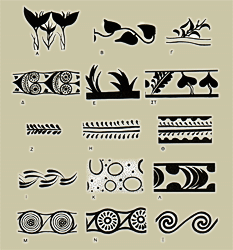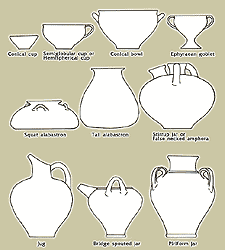| Late Minoan palatial pottery (1550-1050 BC) is considered to be the
acme of Minoan pottery. It enjoyed the appreciation of buyers from all over the known world.
Its decorative themes were complex in design and strongly naturalistic.
This new naturalism of Late Minoan pottery was more realistic
than that of the preceding period. Quite often patterns of animals and plants were used;
not as iconographic themes but as decorative elements.
In the ceramic production of this period there are two main vase-painting styles,
the basic style and the Palace style, which was developed exclusively in palace workshops.
The other styles of palace pottery are the Marine style, the Floral style, the Abstract or
Geometric style, and the Alternating style which combined elements of the other three styles.
|
 After
the devastations of the Late Minoan IB period (1500-1450 BC) in Crete, contact
with Mycenaean Greece became more frequent, giving a new artistic impetus
to Minoan pottery. During the Late Minoan II period (1550-1380 BC) many
Helladic elements appear as a result of these inter-cultural influences.
Typical examples of this period are Palace style jars.
Despite the richness of the decorative motifs, there is an increasing stylisation
of theme which becomes standardized in the Late Minoan III period (1400-1100
BC). After
the devastations of the Late Minoan IB period (1500-1450 BC) in Crete, contact
with Mycenaean Greece became more frequent, giving a new artistic impetus
to Minoan pottery. During the Late Minoan II period (1550-1380 BC) many
Helladic elements appear as a result of these inter-cultural influences.
Typical examples of this period are Palace style jars.
Despite the richness of the decorative motifs, there is an increasing stylisation
of theme which becomes standardized in the Late Minoan III period (1400-1100
BC). |
 The
close links between Crete and the Helladic area during the Late Minoan IIIA-B
period (1400-1200 BC) rank Cretan ceramics with Mycenaean ceramics but at
the same time Cretan workshops were turning out quite a lot of pottery of
a strong local character. The dominant shapes are those also found on the
Greek mainland: Mycenaean kylixes,
cups, skyphoi
and kraters.
Stirrup
jars used for transporting liquids vary considerably in shape,
the largest often bearing
inscriptions detailing the content, such as those recovered in
Mycenaean centres on mainland Greece. The
close links between Crete and the Helladic area during the Late Minoan IIIA-B
period (1400-1200 BC) rank Cretan ceramics with Mycenaean ceramics but at
the same time Cretan workshops were turning out quite a lot of pottery of
a strong local character. The dominant shapes are those also found on the
Greek mainland: Mycenaean kylixes,
cups, skyphoi
and kraters.
Stirrup
jars used for transporting liquids vary considerably in shape,
the largest often bearing
inscriptions detailing the content, such as those recovered in
Mycenaean centres on mainland Greece. |
| Following the destruction of the palace at Knossos in the Late Minoan III A2 period (around 1400 BC)
production was briefly suspended. The general cultural innovations of the Late
Minoan IIIB period (1340-1200 BC) which follow the destruction of the Mycenaean palaces,
are also apparent in Minoan pottery. Production is now characterized by total
independence from Mycenaean work and the gradual establishment of new local
features. In the pottery of the Late Minoan III B period, the mixing of many different elements
from the greater Aegean area is discernible. Two new styles, the Plain and the Close style
make their appearance. Apart from the need for utility ware,
workshops also responded to the for cult objects of a new type such as statuettes, incensories and
stands for other ritual equipment is also met. |
 After
the devastations of the Late Minoan IB period (1500-1450 BC) in Crete, contact
with Mycenaean Greece became more frequent, giving a new artistic impetus
to Minoan pottery. During the Late Minoan II period (1550-1380 BC) many
Helladic elements appear as a result of these inter-cultural influences.
Typical examples of this period are Palace style jars.
Despite the richness of the decorative motifs, there is an increasing stylisation
of theme which becomes standardized in the Late Minoan III period (1400-1100
BC).
After
the devastations of the Late Minoan IB period (1500-1450 BC) in Crete, contact
with Mycenaean Greece became more frequent, giving a new artistic impetus
to Minoan pottery. During the Late Minoan II period (1550-1380 BC) many
Helladic elements appear as a result of these inter-cultural influences.
Typical examples of this period are Palace style jars.
Despite the richness of the decorative motifs, there is an increasing stylisation
of theme which becomes standardized in the Late Minoan III period (1400-1100
BC). The
close links between Crete and the Helladic area during the Late Minoan IIIA-B
period (1400-1200 BC) rank Cretan ceramics with Mycenaean ceramics but at
the same time Cretan workshops were turning out quite a lot of pottery of
a strong local character. The dominant shapes are those also found on the
Greek mainland: Mycenaean kylixes,
cups, skyphoi
and kraters.
Stirrup
jars used for transporting liquids vary considerably in shape,
the largest often bearing
inscriptions detailing the content, such as those recovered in
Mycenaean centres on mainland Greece.
The
close links between Crete and the Helladic area during the Late Minoan IIIA-B
period (1400-1200 BC) rank Cretan ceramics with Mycenaean ceramics but at
the same time Cretan workshops were turning out quite a lot of pottery of
a strong local character. The dominant shapes are those also found on the
Greek mainland: Mycenaean kylixes,
cups, skyphoi
and kraters.
Stirrup
jars used for transporting liquids vary considerably in shape,
the largest often bearing
inscriptions detailing the content, such as those recovered in
Mycenaean centres on mainland Greece.